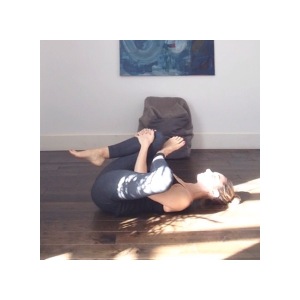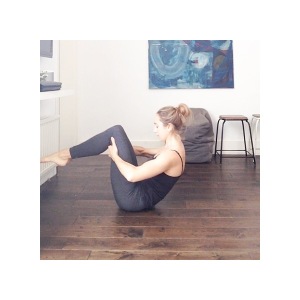There are a lot of contradicting views regarding stretching out there, especially stretches associated with running. In my opinion, what will assist you most seriously, as always, is enjoying and connecting with what you’re trying to achieve. There is no point in making yourself run if you hate running and there is no point in racing through your stretches if you’re not paying attention to what you’re trying to feel and achieve during them.
In an ideal world, our bodies would be balanced and able to move easily and freely through movements because everything is correctly aligned, flexible and stable. However, the majority of us have dysfunction around our bodies: the muscles around our pelvis are weak due to the amount of time we spend sitting, our feet are stiff and lack bounce from squashing them into shoes and pounding around on hard concrete pavements, our ribs are tight from not breathing fully…and so on. So this means we need to spend a little time un-doing our poor postural patterns, and re-learning how to move with ease.
_____________
Before I give you a break down of how best to warm up and warm down I want to remind you of the four essential points you need to consider when engaging in any kind of stretches (be it slow, dynamic or assisted):
1) Keep stretches dynamic and not static – this way your brain will always remember the length at which the muscle lengthens to.
2) Never EVER stretch into pain, aim for 6/10 pain level – this means you won’t activate the fear response, where although you’ll be feeling a stretch, the muscles will be shortening in order to protect from the danger sensed in over stretching.
3) Breathe, relax and release into the stretch – this allows the nervous system to send calm messages around the body letting it know it is in a safe place to let go – in this place you will achieve long term space and flexibility.
4) Keep focused on what you’re trying to achieve – the brain must have a clear objective if it is to achieve any lasting results.
For a deeper break down of these points read here.
_____________
To keep things simple, so you can remember and familiarise yourself with the stretches, I have chosen the same stretches for before and after your run. The major difference is that before your run you will keep the stretches more dynamic (moving) and you will keep them very gentle and within a small range.
The main two reasons you want to save your slower and deeper stretching for after your run is because 1. you can easily injure yourself if you lengthen your muscles then ask them to contract and power you off down the road shortly after; and 2. your muscles relax, release and lengthen far greater when you are warm and have more oxygen, blood and lymph moving around your body.
TIPS WHILE RUNNING
- Think of your joints as springs and your muscles as elastic bands (which they do in fact mechanically resemble)
- Keep your vision eye-level so as to not have the weight of your head dragging your spine into a hunch and your energy down into the ground
- Keep your chest wide and crown of the head reaching to the sky to help keep a sense of space and uplift
- Let your spine and ribcage twist and spring naturally as your arms alternate swinging forward and backward
- Find your rhythm – be it with your breath, the sound of your feet hitting the pavement or internal bouncing
- If you feel the need to rest try instead to keep the flow by opting to walk – try stretching the arms up in the air, or behind your back. This will help give your tissues a bit of space but still challenge your cardiovascular system by having to hold the weight of your arms above or behind your head.
PRE AND POST RUN MOBILISING
The stiffer you are and the colder the temperature is, the more important you spend time warming up. The idea is to go gently; slowly wake your body and nervous system up. Spend roughly 30 -60 seconds on each stretch, but of course spend longer if you are enjoying the stretch and can feel there is more release to be had.
FEET
- Massage your feet (one at a time) on a tennis ball or a spiky ball. Press into the ball as you massage from the front to back of your foot (you may want to hold onto a wall so you can really get in to your feet).
- Sit on your heels with your toes pointing in the same direction as your nose – this stretches the sole of your feet and will help to open the back line of your body (the back of the legs, butt, spine and head)
- Sit on your heels and the front of your feet so the toes are pointing backward – this stretches the front of the feet and will help open the front line of your body (front of the legs, belly, chest, neck and face). Alternate sitting on your heels and tops of your feet for one minute (if this is difficult to do sitting up right then lean forward and rest your hands on the floor)
CALVES
- Stand the front of your feet on the edge of a step, rise up onto your toes and alternate dropping your heels down off the step for one minute (keep your feet pointing forward, eye line level, draw belly into spine and reach the crown of your head to the sky)
LOWER BACK AND SIDES
- Standing with feet parallel a foot or more length distance apart, belly drawn gently in towards your spine, gaze straight ahead. Arms above your head, take hold of your right wrist with your left hand, breathe in, and on the exhale side stretch over to the left, inhale back to centre swap hands, exhale stretch over to the right. Repeat 5 times to each side. Keep arms beside or behind your ears (not in front of your face). Make sure you are not twisting – keep feet, knees, hips and armpits all facing forward. Think of stretching diagonally up and out rather than in a collapsed curve towards the floor.
THIGHS AND HIPS
- Begin standing with your hands on your hips, or on the wall in front of you (shoulder width apart and at shoulder height). Take a step backwards and hold. Point both feet, knees, hips and shoulders straight ahead. Have your spine absolutely upright as if you were standing. Eyes looking straight ahead. Bend both legs, tuck your bottom under by drawing your lower abs upwards. make sure both feet, knees, hips and shoulders are all pointing straight ahead. Have your spine absolutely upright as if you were standing. Eyes looking straight ahead. If you don’t feel much of a stretch, take a bigger step and play with straightening your back leg (see the second image below). Click here for more info on lunges.
SPINE TWIST
- Lie on your back with your legs bent and ‘glued’ to each other – beginners keep your feet on the floor, others take them up in the air, arms wide out to the sides. Exhale – take legs to one side and head to the opposite side, inhale – bring your legs and head back to centre, exhale – go to the opposite side. Every time you exhale make sure you gently sink, wrap and lift your abdominals – your shirt should get baggier! Gently massage the spine into the floor as you go from side to side (i.e. no arching the back).
BUTT
Lie on your back. Cross your left ankle across your right knee and hug the legs in towards you. Aim to keep your hips square, try to keep your butt on the floor. If you can’t do this without your head or butt coming off the floor then put a pillow under your head and keep your right foot (underneath leg) on the floor.
ROLLING LIKE A BALL
- This is great to get massage and stretch the spine and to also get the abs deeply connecting. Lie on your back, hug your knees into your chest, curl your upper body forward, press your knees gently into your hands and hands into knees, shoulders down, elbows wide, keep your belly deepening back towards the spine and gently rock forward and backwards. Inhale forward, exhale back.
BACK OF THE BODY
- Find a bench top or wall and press your palms against the edge of it whilst stepping backwards so you have enough space to bring your spine parallel to the floor. Legs wide apart and at a 90 deg angle to your spine. Softly bend and straighten your legs, trying to stick your butt up to the ceiling.You will feel a stretch happening down the backs of your legs, spine, arms and shoulders. Try to keep your ears between your arms ie. don’t collapse your head down, keep the back of your neck long, gaze to the floor.
SQUAT
- Begin standing; legs just wider than the outside of your hips, feet slightly turned out, arms long beside you. Bend your legs to what feels like half a squat for you, fold at the hips, spine stays straight, head neutral, knees behind toes, weight in heels, take arms forward to shoulder height, palms facing each other. Bend deeper if you can do so without your heels coming away from the floor and without your knees knocking inwards. Press through the middle of the feet and heels to come back up to standing. Exhale through the mouth to go down, breathe in at the bottom, exhale to come back up. Click here for more info on squats.
POST RUN INNER THIGH AND LOWER BACK RELEASE
- If you fancy going a little deeper than a squat after your run then take a wide squat position, aiming knees over your second to third toes, abs gently drawn in. Heels can be on the ground or not – just go with what feels most comfortable. Rest your forearms into your inner thighs and use them to press your legs gently out to the sides keeping your weight through the outsides of your feet (do not let your knees fall inwards). Gently sway side to side to help tease open more release through the inner thighs, pelvis and lower back.
RUN GENTLY ON THE SPOT FOR AT LEAST ONE MINUTE BEFORE YOU START YOUR RUN AND END YOUR RUN WITH A FEW MINUTES OF WALKING (TAKE SLOW CALM BREATHS)
__________________________________________________________________
BONUS RELEASE FOR AFTER YOUR RUN OR AT THE END OF A DAY
SIDE AND FRONT OF LEG MASSAGE – this is of utmost importance if you suffer from shin splints or knee pain.
- If you don’t have a soft tennis ball, spiky ball or foam roller then you can make fists and gently punch and massage up and down the outsides of your hips, thighs and shins. This line often gets tight with running and can cause the knee pain as the knee is being pulled out to the side.
OR 2. Use a soft tennis ball, spiky ball or foam roller to gently massage into the outside of your hip and down the front of your thighs. The key is to relax into the release, if you’re tense and resistant the fascia will struggle to soften and re-set.

















